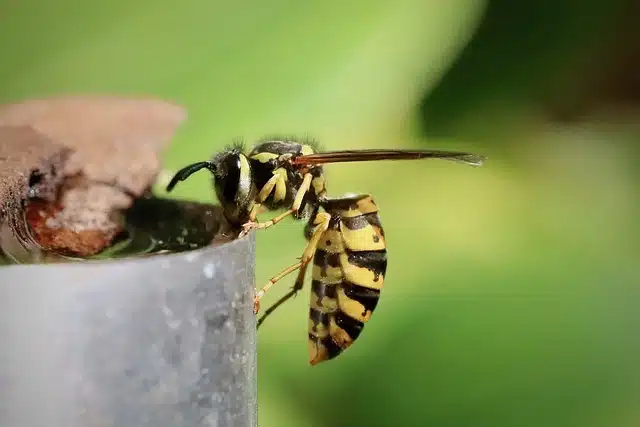Invading wasps make summer pool parties in Phoenix a high-stress event instead of a high-relaxation affair. Not only do these feisty bugs spoil poolside barbecues, but they also create a serious safety hazard to all, especially those families with kiddies in the water. The desert climate in Phoenix also creates near-perfect conditions for wasps to replicate close to water, which poses a serious problem to homeowners.
The hot summer weeks, the lack of natural water sources, and the rich food supply offer attractive residential pools for the local wasp populations. Though quick fixes may be tempting, treating an established wasp nest around your pool area usually needs the assistance of experienced pest control professionals, such as Green Mango Pest Control, in order to be safe and effective.
Why Phoenix Pools Attract Wasps in the First Place?
Wasps must locate dependable water sources to cool their nests and nourish their young due to the lofty temperatures that often exceed 115°F in the extreme Sonoran Desert heat of summer months. In these dry lands, your pool turns into an oasis.
Also, dining and entertaining poolside generate plenty of food choices, sugary drinks, protein from barbecue foods, and even fallen fruit from ubiquitous citrus trees in many Phoenix yards. Wasps can actually cope quite well with chlorinated water, so the treated water in your pool will not deter them.
Common Wasp Behavior Around Pool Areas
- Peak Activity Times
With Phoenix temperatures on the rise during mid-morning through late afternoon, this is when you will find wasps most active. They usually show up around pools between the hours of 10 a.m. and 4 p.m.
- Aggressive Territorial Behavior
After wasps claim a pool area, they begin to claim the space as their own and become more aggressive. Arizona paper wasps and yellowjackets will buzz around swimmers and defend their perceived waterhook against any trespasser.
- Nest-Building Patterns
In the Phoenix area, they often choose to nest in pool equipment enclosures, outdoor furniture, ramadas, decorative boulders, or the many other ‘aesthetics’ we may put into our landscape.
- Feeding Habits Near Water
According to research, wasps can eat or drink up to 15% of their body weight in sugary liquids every day. Spilled drinks by pool decks, outdoor dining areas, and pet food bowls create local feeding stations that promote longer time spent.
- Seasonal Population Swells
During peak summer months, various colonies can grow up to 5,000 individuals, so Phoenix homeowners need to act while the wasp numbers are not as high between May and September.
Why DIY Poolside Wasp Control Often Falls Short
Poolside wasps share some similarities with standard entryway stinging pest problems, like those that arise in early Phoenix homeowner experiences when tackling these situations themselves; however, that can easily become a no-win situation. Commercial sprays provide short-term relief but seldom solve the issue of established nests lurking in pool facilities or neighbouring buildings.
An expert service like Green Mango Pest Control will know the issues specific to desert wasp species and the pool environment. However, they employ particular methods and gear designed to be safe around water features. They also target nests that homeowners often are unable to find/assess safely.
Proactive Steps to Keep Pools Wasp-Free All Summer
- Wipe up any spills, food crumbs, and pet food associated with pool areas. Scouts on the lookout for food sources for the colony are attracted to sweet liquids left behind on deck furniture or outdoor dining room tables.
- Although wasps can withstand chlorinated water, the correct pH balance and sanitization minimize organic material that can lure insects into your pool space.
- Try to have shallow plates of water away from areas of the pool where wasps can congregate. Change the water regularly to prevent mosquito breeding.
- Make sure that the pool areas are inspected and treated early in the spring, well before wasp activity starts to peak.
- Trim bushes and trees around pools and any flowering plants that may attract wasps.
You may also like
-
What Affects the Cost of Serviced Apartments in Singapore?
-
How Offshore Cleaning Differs Between Oil Platforms and Wind Farms
-
What Are the Different Types of Concrete Foundations in Commercial Construction
-
Locksmith 2025: A Perfect Mix of Security Solutions and Professionalism
-
Top 5 HOA and Accounting Software Solutions

